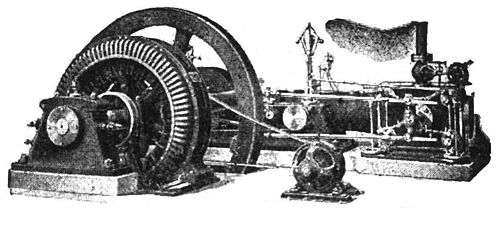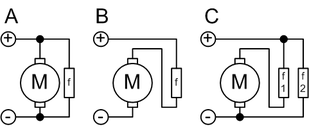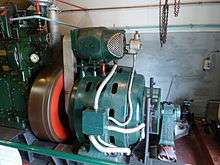Excitation (magnetic)

An electric generator or electric motor consists of a rotor spinning in a magnetic field. The magnetic field may be produced by permanent magnets or by field coils. In the case of a machine with field coils, a current must flow in the coils to generate the field, otherwise no power is transferred to or from the rotor. The process of generating a magnetic field by means of an electric current is called excitation. Field coils yield the most flexible form of magnetic flux regulation and de-regulation, but at the expense of a flow of electric current. Hybrid topologies exists, which encorporate both permanent magnets and field coils in the same configuration. The flexible excitation of a rotating electrical machine is employed by either brushless excitation techniques or by the injection of current by carbon brushes (static excitation).
Excitation in generators



For a machine using field coils, as is the case in most large generators, the field must be established by a current in order for the generator to produce electricity. Although some of the generator's own output can be used to maintain the field once it starts up, an external source of current is needed for starting the generator. In any case, it is important to be able to control the field since this will maintain the system voltage.
Amplifier principle
Except for permanent magnet generators, a generator produces output voltage proportional to the magnetic field, which is proportional to the excitation current; if there is no excitation current there is no voltage. A small amount of power supplied as field current may thus control a large amount of generated power and can be used to modulate it. This principle is very useful for voltage control: If the output voltage of the system is less than desired, the excitation voltage can be increased; if the output voltage is high, excitation can be decreased. A synchronous condenser operates on the same principle, but there is no "prime mover" power input; however, the "flywheel effect" means that it can send or receive power over short periods of time. To avoid damage to the machine through erratic current changes, a ramp generator is often used. A generator can thus be considered as an amplifier:
Separate excitation

For large, or older, generators, it is usual for a separate exciter dynamo to be operated in conjunction with the main power generator. This is a small permanent-magnet or battery-excited dynamo that produces the field current for the larger generator.
Self excitation
Modern generators with field coils are usually self-excited, i.e., some of the power output from the rotor is used to power the field coils. The rotor iron retains a degree of residual magnetism when the generator is turned off. The generator is started with no load connected; the initial weak field induces a weak current in the rotor coils, which in turn creates an initial field current, increasing the field strength, thus increasing the induced current in the rotor, and so on in a feedback process until the machine "builds up" to full voltage.
- Starting
Self-excited generators must be started without any external load attached. An external load will continuously drain off the buildup voltage and prevent the generator from reaching its proper operating voltage.
- Field flashing
If the machine does not have enough residual magnetism to build up to full voltage, usually a provision is made to inject current into the rotor from another source. This may be a battery, a house unit providing direct current, or rectified current from a source of alternating current power. Since this initial current is required for a very short time, it is called "field flashing". Even small portable generator sets may occasionally need field flashing to restart.
The critical field resistance is the maximum field circuit resistance for a given speed with which the shunt generator would excite. The shunt generator will build up voltage only if field circuit resistance is less than critical field resistance. It is a tangent to the open circuit characteristics of the generator at a given speed.
Brushless excitation
Brushless excitation creates the magnetic flux on the rotor of electrical machines without the need of carbon brushes. It is typically used for reducing the regular maintenance costs and to reduce the risk of brush-fire. It was developed in the 1950s, as a result of the advances in high-power semiconductor devices [1]. The concept was using a rotating diode rectifier on the shaft of the synchronous machine to harvest induced alternating voltages and rectify them to feed the generator field winding [2][3][4].
Brushless excitation has been historically lacking the fast flux de-regulation, which has been a major drawback. However, new solutions have emerged [5]. Modern rotating circuitry incorporates active de-excitation components on the shaft, extending the passive diode bridge [6][7][8]. Moreover, their recent developments in high-performance wireless communication[9][10] have realized fully controlled topologies on the shaft, such as the thyristor rectifiers and chopper interfaces [11][12][13][14][15][16][17].
References
- ↑ Fenwick, D.R.; Wright, W.F. (1976). "Review of trends in excitation systems and possible future developments". Proceedings of the Institution of Electrical Engineers. 123 (5): 413. doi:10.1049/piee.1976.0093. ISSN 0020-3270.
- ↑ Salah, Mohamed; Bacha, Khmais; Chaari, Abdelkader; Benbouzid, Mohamed El Hachemi (2014-09). "Brushless Three-Phase Synchronous Generator Under Rotating Diode Failure Conditions". IEEE Transactions on Energy Conversion. 29 (3): 594–601. doi:10.1109/tec.2014.2312173. ISSN 0885-8969. Check date values in:
|date=(help) - ↑ Zhang, YuQi; Cramer, Aaron M. (2017-12). "Numerical Average-Value Modeling of Rotating Rectifiers in Brushless Excitation Systems". IEEE Transactions on Energy Conversion. 32 (4): 1592–1601. doi:10.1109/tec.2017.2706961. ISSN 0885-8969. Check date values in:
|date=(help) - ↑ Nuzzo, Stefano; Galea, Michael; Gerada, Chris; Brown, Neil (2018-04). "Analysis, Modeling, and Design Considerations for the Excitation Systems of Synchronous Generators". IEEE Transactions on Industrial Electronics. 65 (4): 2996–3007. doi:10.1109/tie.2017.2756592. ISSN 0278-0046. Check date values in:
|date=(help) - ↑ Nøland, Jonas Kristiansen (2017). "A New Paradigm for Large Brushless Hydrogenerators : Advantages Beyond the Static System". DIVA.
- ↑ Rapid de-excitation system for synchronous machines with indirect excitation, 2010-02-11, retrieved 2018-05-28
- ↑ Rebollo, Emilio; Blazquez, Francisco; Blanquez, Francisco R.; Platero, Carlos A.; Redondo, Marta (2015-07-01). "Improved high-speed de-excitation system for brushless synchronous machines tested on a 20 MVA hydro-generator". IET Electric Power Applications. 9 (6): 405–411. doi:10.1049/iet-epa.2014.0313. ISSN 1751-8660.
- ↑ Rebollo, Emilio; Platero, Carlos A.; Blazquez, Francisco; Granizo, Ricardo (2017-04-01). "Internal sudden short-circuit response of a new HSBDS for brushless synchronous machines tested on a 15 MVA generator". IET Electric Power Applications. 11 (4): 495–503. doi:10.1049/iet-epa.2016.0525. ISSN 1751-8660.
- ↑ Pang, Zhibo; Luvisotto, Michele; Dzung, Dacfey (2017-09). "Wireless High-Performance Communications: The Challenges and Opportunities of a New Target". IEEE Industrial Electronics Magazine. 11 (3): 20–25. doi:10.1109/mie.2017.2703603. ISSN 1932-4529. Check date values in:
|date=(help) - ↑ Llano, Danilo X.; Abdi, Salman; Tatlow, Mark; Abdi, Ehsan; McMahon, Richard A. (2017-09-09). "Energy harvesting and wireless data transmission system for rotor instrumentation in electrical machines". IET Power Electronics. 10 (11): 1259–1267. doi:10.1049/iet-pel.2016.0890. ISSN 1755-4535.
- ↑ Rotating electrical machine, 2014-05-28, retrieved 2018-05-28
- ↑ Systems and methods concerning exciterless synchronous machines, 2017-10-06, retrieved 2018-05-28
- ↑ Noland, Jonas Kristiansen; Hjelmervik, Karina Bakkelokken; Lundin, Urban (2016-03). "Comparison of Thyristor-Controlled Rectification Topologies for a Six-Phase Rotating Brushless Permanent Magnet Exciter". IEEE Transactions on Energy Conversion. 31 (1): 314–322. doi:10.1109/tec.2015.2480884. ISSN 0885-8969. Check date values in:
|date=(help) - ↑ Noland, Jonas Kristiansen; Evestedt, Fredrik; Perez-Loya, J. Jose; Abrahamsson, Johan; Lundin, Urban (2017-05). "Design and Characterization of a Rotating Brushless Outer Pole PM Exciter for a Synchronous Generator". IEEE Transactions on Industry Applications. 53 (3): 2016–2027. doi:10.1109/tia.2017.2669890. ISSN 0093-9994. Check date values in:
|date=(help) - ↑ Noland, Jonas Kristiansen; Evestedt, Fredrik; Perez-Loya, J. Jose; Abrahamsson, Johan; Lundin, Urban (2018-03). "Testing of Active Rectification Topologies on a Six-Phase Rotating Brushless Outer Pole PM Exciter". IEEE Transactions on Energy Conversion. 33 (1): 59–67. doi:10.1109/tec.2017.2746559. ISSN 0885-8969. Check date values in:
|date=(help) - ↑ Noland, Jonas Kristiansen; Evestedt, Fredrik; Perez-Loya, J. Jose; Abrahamsson, Johan; Lundin, Urban (2018-02). "Comparison of Thyristor Rectifier Configurations for a Six-Phase Rotating Brushless Outer Pole PM Exciter". IEEE Transactions on Industrial Electronics. 65 (2): 968–976. doi:10.1109/tie.2017.2726963. ISSN 0278-0046. Check date values in:
|date=(help) - ↑ Noland, Jonas Kristiansen; Evestedt, Fredrik; Lundin, Urban (2018). "Failure-Modes Demonstration and Redundant Postfault Operation of Rotating Thyristor Rectifiers on Brushless Dual-Star Exciters". IEEE Transactions on Industrial Electronics: 1–1. doi:10.1109/tie.2018.2833044. ISSN 0278-0046.
- ↑ Electrical Technology - II by B.L.Thereja
- ↑ Electrical Machines - I by U.A.Bakshi, V.U Bakshi